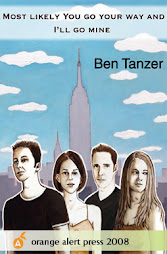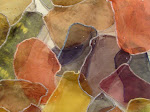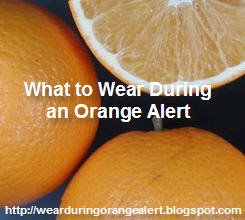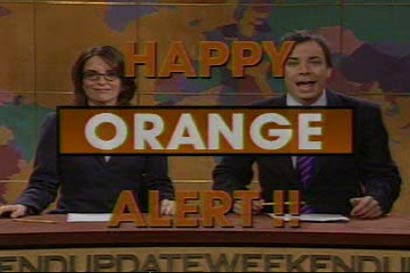
Julie Peppito
In a world filled with endless wars, toxic chemicals and waste, consistent death and misery, the average viewer/consumer has to come to a point where he/she must scream, "No More!". Whether it is television, newspaper, internet, or just life we are flooded by the images of reality. A reality that as a child you never could have imagined would have been possible. However, we are forced to witness these realities on a daily basis while attempting in vain to maintain the innocence we were once given. One artist who is utilizing this reality to create fantasy is Brooklyn resident, Julie Peppito.
Julie in her words "transforms trinkets, trash, and the residue of Americana into paintings, statuettes, collages and installations". In many of her pieces the sketch begins at a place innocence or familiarity and then the layers of color and object begin to build. They build until nearly the point of chaos, but unlike reality where there seems to be absolutely no control, Julie is very much in control of her pieces. Yet, it is that contrast between reality and fantasy that has drawn so many to her work.
Recently, Julie was kind enough to answer a few of my questions.


OA: There are several military and political images in your work. Has the current war had a significant impact you and your work or is it simply a current event and therefore a subject?
JP: Yes. I don't think that even if you are a landscape painter you can avoid talking about the war. It is in the national and worldwide consciousness. If you are not talking about it directly you are avoiding talking about it and therefore talking about it. I choose to both avoid talking about it and talk about it - if that makes any sense. I express the two oppositions that are always at war within myself - the need to escape the horror of this war and our despicable role in it and my need to face the reality of it, and my part in it. What I have struggled most over in my art is to bring together my feelings of confusion, frustration and rage over the way the world is and my love of fantasy, escape and beauty. By the way, I'm not knocking landscape painting, or anyone who chooses not to speak about politics with their work. It is something that I need to do.
OA: Do you have a set color palette? Do you ever use color to evoke a particular emotion or feeling in the viewer?
JP: I don't consciously have a palette but I think i instinctively often end up using the same or similar colors. I do consciously use red & pink sometimes for more impact or to symbolize emotion, passion or blood.
OA: What's next for Julie Peppito?
JP: I just got back from Miami and was in two art fairs there: Flow & Aqua. The galleries I worked with, Heskin Contemporary and Julie Baker Fine Art, both did very well with my work. I sold work and met many curators, collectors and artists. I'm hoping that some interesting show opportunities will come out of that. I've gotten some commissions where I incorporate other peoples stuff (sentimental and throw-away) into pieces for them. This is exciting to me - to be able to make portraits of them through the stuff they collect and use.

Bonus Questions:
OA: In a recent interview you listed punk rock as influence on your work. Who are some of your favorite punks bands? Are there others any other types of music or musicians you listen to?
Hip Hop: Public Enemy, The Coup and Mr. Lif.

Orange Alert (OA): The way you mix childlike images with color explosions and chaos brings to mind a loss of innocence. Would you say that is a common theme in your work?
Julie Peppito (JP): Yes I would. It's a personal loss of innocence - like when I came to New York City from Oklahoma and was exposed to news media that was not owned by corporations (WBAI, Democracy Now!). I learned the ways we are lied to and how those lies have hurt us by keeping us 'innocent' (oblivious) as a society. For example, I heard about global warming and the many facts that support it many years ago, many Oklahomans are only now beginning to believe it because the rhetoric of the oil industry is so ingrained there. Also, you're kept in this shopping bubble far from the reality of those who make the things you buy and the impact that that production has on the environment. Of course that happens in New York too, but if you choose to you can get a different perspective on it here.
OA: What are some of the major influence on your work?
JP: Flying beings, crawling beings, rolling beings, beings with personality and feeling (including human beings), trees. And folk art from many cultures: Native America, India, China, Mexico and Americana. Also, my husband Gideon Kendall - I make much of my work for him.
Julie Peppito (JP): Yes I would. It's a personal loss of innocence - like when I came to New York City from Oklahoma and was exposed to news media that was not owned by corporations (WBAI, Democracy Now!). I learned the ways we are lied to and how those lies have hurt us by keeping us 'innocent' (oblivious) as a society. For example, I heard about global warming and the many facts that support it many years ago, many Oklahomans are only now beginning to believe it because the rhetoric of the oil industry is so ingrained there. Also, you're kept in this shopping bubble far from the reality of those who make the things you buy and the impact that that production has on the environment. Of course that happens in New York too, but if you choose to you can get a different perspective on it here.
OA: What are some of the major influence on your work?
JP: Flying beings, crawling beings, rolling beings, beings with personality and feeling (including human beings), trees. And folk art from many cultures: Native America, India, China, Mexico and Americana. Also, my husband Gideon Kendall - I make much of my work for him.
OA: You have some very interesting titles, how much thought goes into the titles of your pieces?
JP: Sometimes they just come to me, sometimes I labor over them, sometimes I ask Gideon what he thinks. When I was younger I used to hate titling my work because I thought it sounded fake or pretentious. But then I realized I had something to say and words helped with that.
JP: Sometimes they just come to me, sometimes I labor over them, sometimes I ask Gideon what he thinks. When I was younger I used to hate titling my work because I thought it sounded fake or pretentious. But then I realized I had something to say and words helped with that.

OA: There are several military and political images in your work. Has the current war had a significant impact you and your work or is it simply a current event and therefore a subject?
JP: Yes. I don't think that even if you are a landscape painter you can avoid talking about the war. It is in the national and worldwide consciousness. If you are not talking about it directly you are avoiding talking about it and therefore talking about it. I choose to both avoid talking about it and talk about it - if that makes any sense. I express the two oppositions that are always at war within myself - the need to escape the horror of this war and our despicable role in it and my need to face the reality of it, and my part in it. What I have struggled most over in my art is to bring together my feelings of confusion, frustration and rage over the way the world is and my love of fantasy, escape and beauty. By the way, I'm not knocking landscape painting, or anyone who chooses not to speak about politics with their work. It is something that I need to do.
OA: Do you have a set color palette? Do you ever use color to evoke a particular emotion or feeling in the viewer?
JP: I don't consciously have a palette but I think i instinctively often end up using the same or similar colors. I do consciously use red & pink sometimes for more impact or to symbolize emotion, passion or blood.
OA: What's next for Julie Peppito?
JP: I just got back from Miami and was in two art fairs there: Flow & Aqua. The galleries I worked with, Heskin Contemporary and Julie Baker Fine Art, both did very well with my work. I sold work and met many curators, collectors and artists. I'm hoping that some interesting show opportunities will come out of that. I've gotten some commissions where I incorporate other peoples stuff (sentimental and throw-away) into pieces for them. This is exciting to me - to be able to make portraits of them through the stuff they collect and use.
Also, I've been working on a series of flying creatures. I hope to be able to make enough to fill a room with them and make an installation called "Swarm" - a cross between a fantastical environment that I imagine escaping into and the nightmares that I have of what will become of our world if we continue on this path of environmental degradation and war. I have already done a small installation of this with four creatures.
Lastly, a playground I worked on was completed last year near The Brooklyn Museum. I hope to design more pieces for playgrounds very soon.

Bonus Questions:
OA: In a recent interview you listed punk rock as influence on your work. Who are some of your favorite punks bands? Are there others any other types of music or musicians you listen to?
JP: Wow, there are so many:
Punk/New Wave: Au Pairs, Xray Spex, Gang of Four, Devo, Dogfaced Hermans, Wire, The Fall, Dead Kennedys, Gary Numan's Tubeway Army, Pretenders.
Punk/New Wave: Au Pairs, Xray Spex, Gang of Four, Devo, Dogfaced Hermans, Wire, The Fall, Dead Kennedys, Gary Numan's Tubeway Army, Pretenders.
Hip Hop: Public Enemy, The Coup and Mr. Lif.
Other: MIA, Bjork, Grandaddy, Flaming Lips, Guided By Voices, Roxy Music, Led Zepplin, Jimmy Hendrix, David Bowie, Cooling Pies (I'm in it, so is Gideon), Fake Brain (Gideon's old band).
www.myspace.com/coolingpies
www.myspace.com/fakebrain
www.myspace.com/coolingpies
www.myspace.com/fakebrain
There are many more.
OA: Has there ever been an object you thought of putting into a piece, but then felt it would be to distracting or unusual? Basically, is there any object or thing that you would not put into a piece?
JP: It depends on the piece some objects don't work in some pieces. But I think I could always find a place for any object even if I have to design a new piece around it.
OA: Has there ever been an object you thought of putting into a piece, but then felt it would be to distracting or unusual? Basically, is there any object or thing that you would not put into a piece?
JP: It depends on the piece some objects don't work in some pieces. But I think I could always find a place for any object even if I have to design a new piece around it.
For more information on Julie Peppito please visit her website.
+by+Nick+Volkert).jpg)





















No comments:
Post a Comment